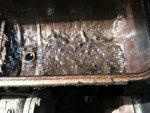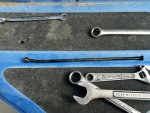Oldfart
Well-known member
- 1,063
- 26
- 48
- Location
- Centennial,CO
Number 5 is most likely valves or a burned piston. Upper cylinder cleaner is most effective for gummed up rings, but can help with valves if they are just carbonized up and not seating all the way. Given the higher compressions at each end of the block, (the end cylinders tend to run a little leaner than those closer to the carb) it might be old leaded fuel deposits gumming things up a bit. Did you run your compression test dry only? If you did, you might try oiling each hole before you test it. The oil will seal up things like valves not seating completely or stuck rings. You should see an improvement between dry and wet readings (except on number 5). How much of an improvement will give you a clue as to what might be dropping the compressions. Another thought on number 5 is the possibility of a broken valve spring allowing the valve to hang open. If its an intake valve, you would hear burping in the carb with the air cleaner disconnected. If the exhaust valve, then it should flutter a piece of paper held across the tail pipe (usually can hear it as well.) If a burned piston, there should be blow by and oil in the exhaust. While readings in the 60's are somewhat low, they are runnable. 90psi is good and 105 is excellent for a low compression military engine at your altitude. If the middle cylinders are low due to ring wear, a slightly higher viscosity oil will help some. As to number 5, it really needs to get fixed. Having said that, I have seen guys extend the use of an engine with a bad hole by removing the spark wire and in one case, the spark plug was removed as well. The latter did not make sense to me as there was all sorts of whooshing and depending on which valve was open or burned, exhaust or intake gasses could escape the plug hole.
Bob
Bob



